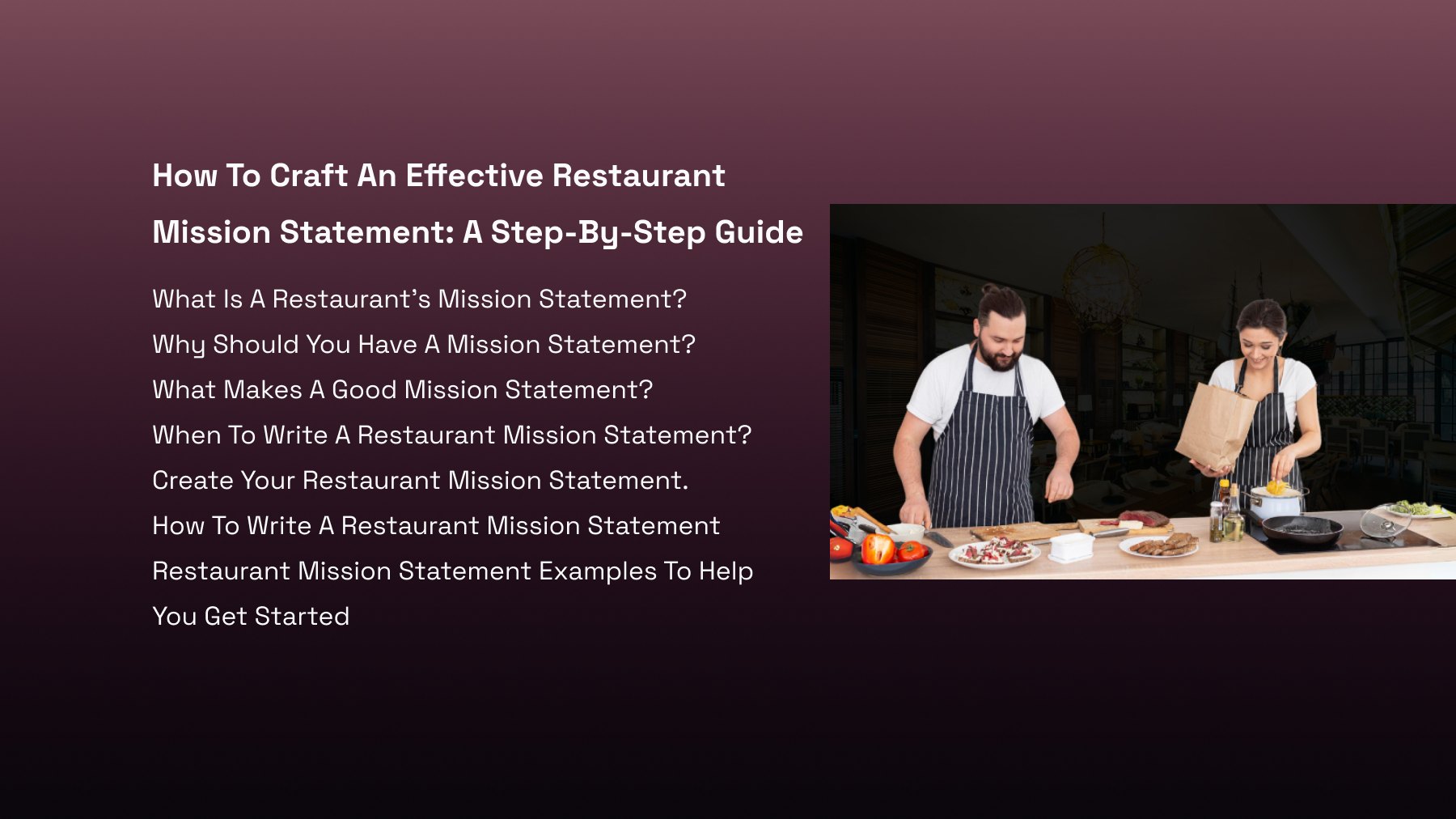How to Craft an Effective Restaurant Mission Statement: A Step-by-Step Guide
Your restaurant's mission statement outlines your values for internal and external customers (workers, stakeholders, and diners). It is an important component of your brand identity and will have a direct and significant impact on how you implement it in management.
Most restaurant mission statements are basic and effective, but few are spectacular. Knowing why and how to construct an amazing mission statement is useful whether starting a new restaurant or updating an existing one.
Discover why restaurants should have a mission statement, what makes it good, and when and how to write a mission statement for a restaurant in this blog post.
A restaurant's mission statement is a brief summary of the company's purpose and goal. Restaurant managers usually develop mission statements for their businesses to promote the brand's image and provide the public with an understanding of its values. Mission statements can also help describe how a business differs from its competitors. They can be displayed on restaurants' premises or used in advertisements, advertisements, and promotional materials.
Why Should You Have a Mission Statement?
Determining your restaurant's mission statement is important for a variety of reasons. If someone asks you about your restaurant's primary focus and business goals, a mission statement is an excellent approach to explain what you're about.
Here are a few reasons why it's important to develop a strong mission statement for your restaurant.
To clearly describe your restaurant's purpose for customers and stakeholders.
Your customers should be aware of what to expect. Will they find homemade comfort food in your restaurant? Or will they get a true cultural experience?
You should describe what you do at a very high level. Even if your menu or operations change, your goal statement should not change.
To focus your attention when working on your business plan.
Your mission statement serves as the foundation for all the activities outlined in your business plan. When choosing menu items, establishing customer service standards, and developing your marketing plan, keep your goal statement in mind.
Tell customers and stakeholders how you're different.
There may be ten burger joints in your neighborhood, but there is something that distinguishes you from the crowd. That something should be clearly stated in your mission statement.
To help customers remember you.
A well-written mission statement can influence a customer's experience before and after they visit your restaurant. Your goal is to ensure that their experience aligns with your mission.
What Makes a Good Mission Statement?
You might be wondering, “What makes a good mission statement?" An effective mission statement describes:
- What does your restaurant do?
- How do you deliver your customer experience?
- Why did you open your restaurant?
- What Your Customer Can Expect
- The value you bring to consumers, employees, and stakeholders
When a mission statement is effective, it
- Uses concise language.
- Sets expectations.
- Addresses customer needs.
- Provides direction for your restaurant's activities
- Declares your competitive advantages.
- Describe your value in simple words.
- Drives all decisions.

When to Write a Restaurant Mission Statement?
If you are launching a new restaurant business, you should finish the mission statement draft following the SWOT analysis. The four areas – strengths, weaknesses, opportunities, and threats – can help you determine the purpose of your restaurant and what should be included in your mission statement. After you've established your mission statement, you can go on to your company plan.
A SWOT analysis should be performed on any brand refresh, new location, or new processes in an existing restaurant. Always double-check your restaurant's mission statement after any changes to ensure it remains true to its goal.
Create Your Restaurant Mission Statement
To get started, learn how other restaurants convey their goal and vision. Some restaurants have long stories, while others have short, simple lines. Create a goal statement that reflects you while being true to your identity.
Strong value, vision, mission, and culture statements are critical for restaurants to maintain business integrity.
Continue reading to find out how these four key claims differ.
1. Value Statement
Your values shape the decisions you make and the people you collaborate with. As a result, your value statement should be defined before moving to the next statement or idea.
When starting off on your value statement, it may be helpful to highlight a couple of your competitive traits.
Try not to discuss what your restaurant does or what you have planned in this statement, as this will be covered in your vision and goal. Instead, your value statement should be a concise, compelling explanation of your company's beliefs.
2. Vision Statement
After you've defined your value statement, you can go on to your vision statement. It is all about why your restaurant concept is important and how it can impact the community.
One way to focus on your vision statement is to see it as the “what" component of your restaurant's objectives. What are your goals? How does this vision distinguish you from your competitors? It might assist in recalling your original reasons for launching the restaurant. Consider what you imagined for your concept and what it would represent to others.
3. Mission Statement
If your restaurant's vision statement is the how then its purpose is the what. Your mission outlines how you want to make your objectives and desires come true.
Restaurant mission statements can be a few phrases long, but they are often brief and to the point. Some of the most well-known restaurant mission statements only contain a few words. The finest restaurant mission statements cater to the audience's desires while remaining honest about what the restaurant is striving to achieve.
4. Cultural statement
It can be difficult to tell the difference between a culture statement and a mission statement. Consider your mission statement to be an external force and your cultural statement to be an internal force.
After all, your culture is entirely internal, and it governs how people engage with customers, what employees value, and what your workforce stands for. Having said that, your cultural statement should include all of the above.
Now that you know what you're making, you must be inspired.
How to Write a Restaurant Mission Statement
1. Get inspired by competition
When looking for good restaurant mission statements, look for companies with similar missions to yours.
Next, consider drawing inspiration from well-known restaurant goal statements. Because well-known restaurants are profitable, there may be something special hidden in their mission statement that sustains and propels the business ahead. Just make sure you're inspired by these statements rather than taking them!
2. Look at your idols
To find a successful example of a restaurant or bar's mission and vision statement, look to establishments you admire. These can be either local or global businesses, and it makes no difference what kind of drinks or food they serve.
The most important thing is to take note of what you value when looking at various restaurant and bar mission statement examples. Perhaps you enjoy the length, perhaps you want to replicate the language. Being specific in your research will allow you to build an inspired and focused mission.
3. Consider your customers
Another important aspect to keep in mind when creating your restaurant mission statement is the needs of your guests. What sub-populations live in your community? What other area establishments already serve the groups you're looking for, and where is there room for expansion? Consider what people value in their lives and in the businesses, they patronize, and consider how a mission statement can connect to those values to provoke an emotional response.
Whether you're targeting military families, college students, or retired seniors, your restaurant's mission statement should represent their interests.
4. Keep it fresh and unique
If you're tempted to steal a restaurant mission statement sample from the internet, try to resist. You don't want to convey the idea that your restaurant is just like everyone else when it first menus since if you do, customers will have no reason to visit.
Furthermore, the top restaurant mission statements take a stand on something new and different. They encourage people to think beyond food and explore culture, ideas, and people. Instead of following in someone else's footsteps, craft your goal on what you're trying to accomplish and why customers should support it.
You can also read our latest blog on branding your restaurant expert tips and tricks.
Restaurant Mission Statement Examples to Help You Get Started
1) McDonald's Mission Statement
The McDonald's brand mission is to be our customers' favorite place and way to eat and drink. Our global operations are unified with a global strategy known as the Plan to Win, which focuses on providing a great customer experience through People, Products, Place, Price, and Promotion. We are dedicated to continuously improving our operations and our customer experience.
2 ) Dunkin' Donuts' Mission Statement
To be the premier provider of a diverse choice of delicious beverages and baked goods throughout the kingdom in a convenient, relaxing, and welcoming environment that ensures the highest level of product quality and value for money. We provide our guests with exceptional service and an amazing experience on every visit.
3) Buffalo Wild Wings' Mission Statement
Every day, we strive to impress others! We are guest-driven: Every day, we will WOW our visitors by providing the highest level of satisfaction with an unparalleled focus on friendly service, food, fun, and value.
We are team-oriented: We will WOW our team members by treating them with the same respect, positive encouragement, and fair treatment that we want Team Members to share externally with every guest.
We are community-connected: We will WOW the communities where we do business by demonstrating good citizenship and contributing to their improvement as places to live, work, and thrive.
We are committed to excellence: we will wow our stakeholders with great, industry-leading financial and operational results.
4) Panda Express's Mission Statement
To provide great Asian dining experiences by creating an organization that inspires people to better themselves.
5) Applebee's Mission Statement
To contribute to the development, joy, and enrichment of all the lives we touch.
6) Wendy’s Mission Statement
To provide high-quality products and services to our customers and communities through leadership, innovation, and collaboration.
7) Cheesecake Factory's Mission Statement
To create an environment where complete visitor happiness is our top goal.

What Should You Do After You've Completed Your Restaurant Mission Statement?
Now that you've created a well-written restaurant mission statement, it's time to strategize how you'll achieve it. Create your vision statement, define your beliefs, and tie it all together in the business plan. Whether you're starting a new restaurant or revamping an old one, your business plan should constantly be updated to reflect your overall goal.
You can also get your hands on the top things you should know about service charges vs. Tips.
